* (restored/upgraded/revised)

‘There is no why for my making films. I just liked the twitters of the machine, and since it was an extension of painting for me, I tried it and loved it. In painting I never liked the staid and static, always looked for what would change the source of light and stance, using glitters, glass beads, luminous paint, so the camera was a natural for me to try but how expensive!’ — Marie Menken
‘The realist sees only the front of a building, the outlines, a street, a tree. Marie Menken sees in them the motion of time and eye. She sees the motions of heart in a tree. … A rain that she sees, a tender rain, becomes the memory of all rains she ever saw; a garden that she sees becomes a memory of all gardens, all color, all perfume, all mid-summer and sun.’ – Jonas Mekas
‘Marie Menken (1910-1970) is the unsung heroine of the American avant-garde cinema. Best known for her role as a protagonist in Andy Warhol’s Chelsea Girls, she was, far more importantly, a mentor, muse and major influence for such key experimental filmmakers as Kenneth Anger, Stan Brakhage, Jonas Mekas and Andy Warhol. Menken created an extraordinary body of exuberant and stunningly beautiful films shaped, above all, by her intuitive understanding of handheld cinematography. Beginning with her celebrated first film, Visual Variations on Noguchi (1945), Menken used the hand-cranked Bolex camerafavored by avant-garde filmmakers to introduce a new agility, grace and spontaneity into experimental cinema, a lightness of camera and form hitherto unseen in American film.
‘With Noguchi, Menken also began a spirited dialogue between cinema and the plastic and painterly arts that extends across her films in a witty yet deeply insightful exploration of the formal language and methodology specific to those schools and painters with whom Menken was close – from the Abstract Expressionist drip painting humorously critiqued in Drips in Strips (1963), to the factory production of Pop art in the revelatory Andy Warhol (1964) and the Fluxus practice of Robert Watts in Watts with Eggs (1967).
‘The longtime creative and marital partner of poet-filmmaker Willard Maas, Menken began as an accomplished painter whose eccentrically textured and effulgent canvases incorporate all manner of reflective media – phosphorescent paint, crushed glass, sequins – in a playful challenge to the traditional boundaries of the painted canvas. Light remained a major focus of Menken’s films, most notably in major works such as Notebook (1940-62) and Lights (1964-66) which transform her Bolex into an instrument for painting marvelous sculptural forms from neon and city lights.
‘Like the painters-turned-filmmakers Robert Breer and Carmen D’Avino, Menken (who animated the chess sequence in Maya Deren’s At Land) embraced various animation techniques – collage, stop-motion cinematography – as a direct extension of her painting. Yet for Menken, animation also became a way of radically transforming the world around her, reimagining postwar New York City, for example, in her masterpiece of single frame cinematography Go! Go! Go! (1962-64), a work that condenses two years of patient documentary filmmaking into a delirious and exhilarating vision of a hyperactive city.
‘An important first step towards the recuperation of Menken as a major artist and figure in the postwar avant-garde scene, Martina Kudláček’s recent documentary Notes on Marie Menken (2006) includes rare footage and revealing interviews with a number of close friends and colleagues such as Anger, Mekas, Gerard Malanga and Alfred Leslie.’ — collaged
__
Stills







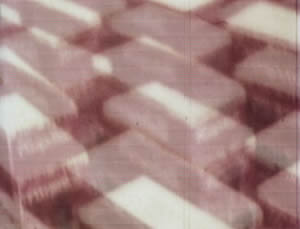





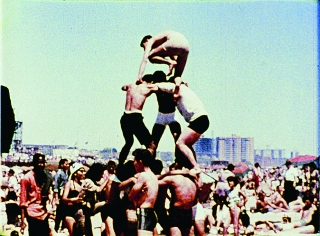






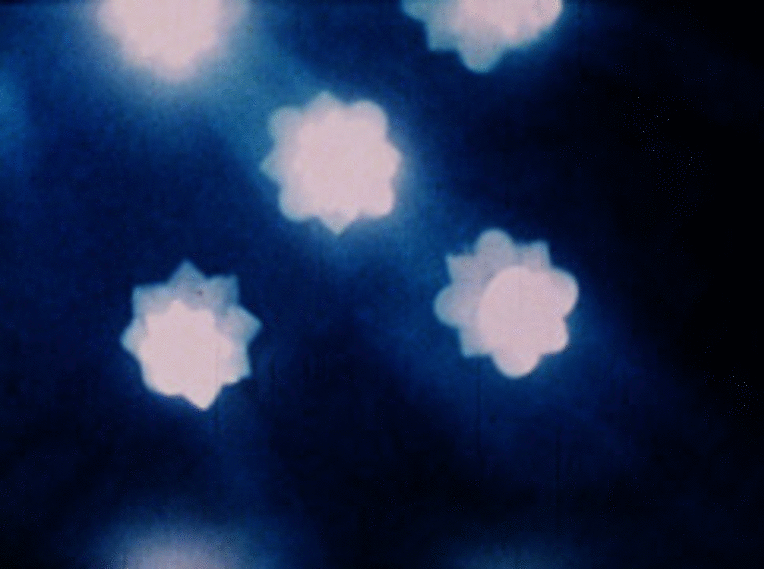
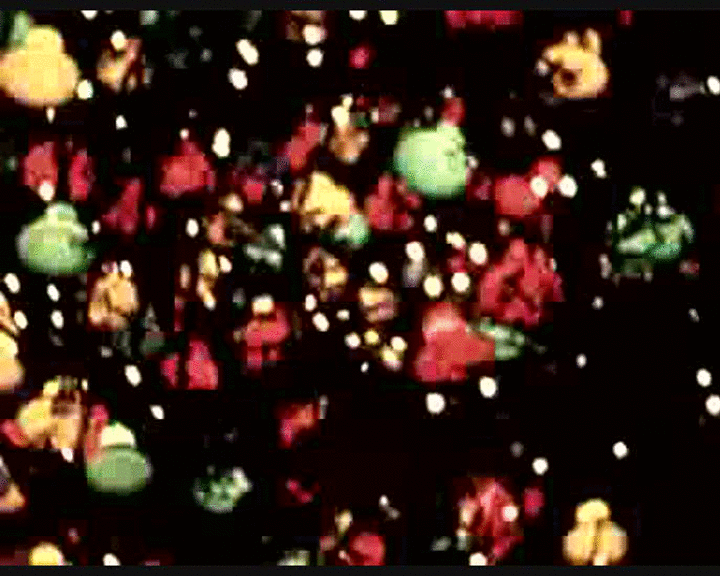
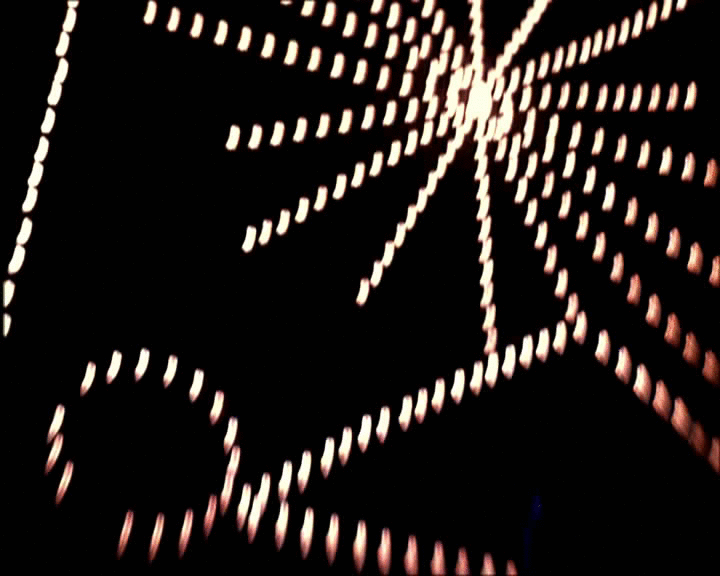
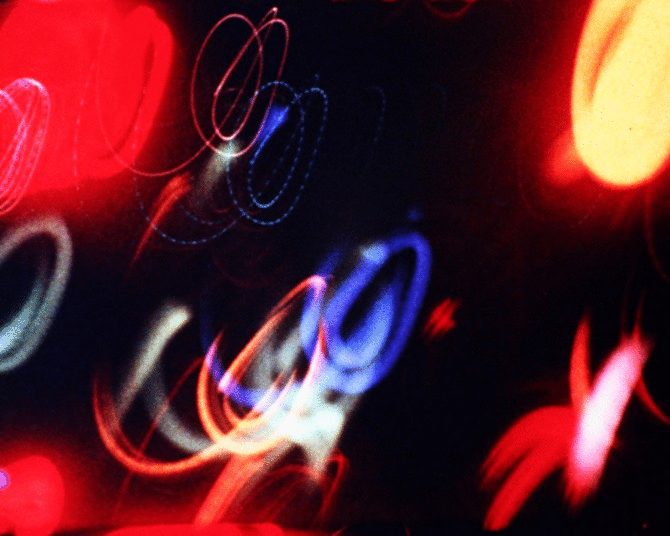
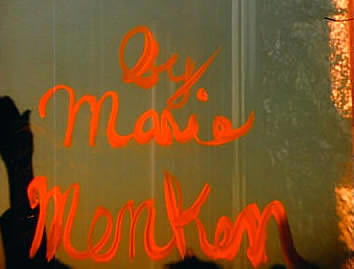


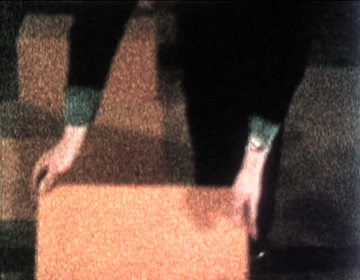

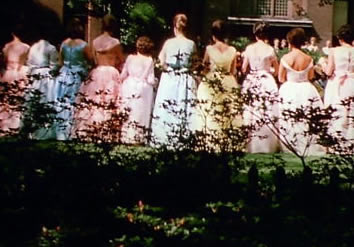

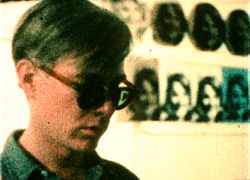

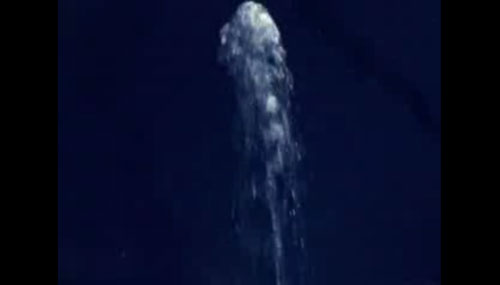



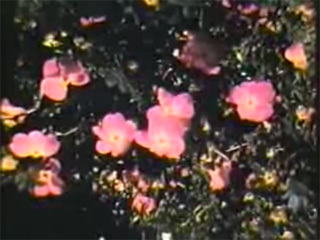
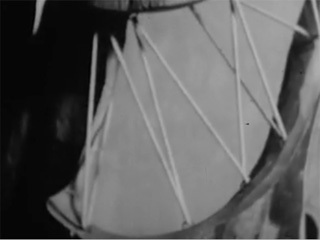
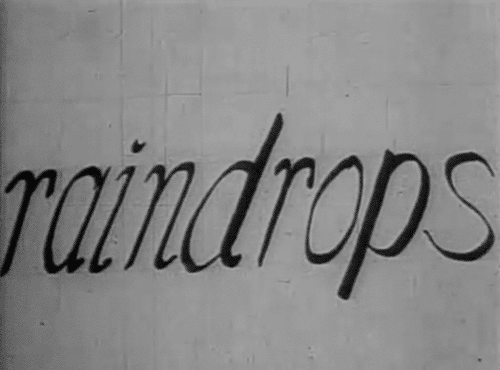












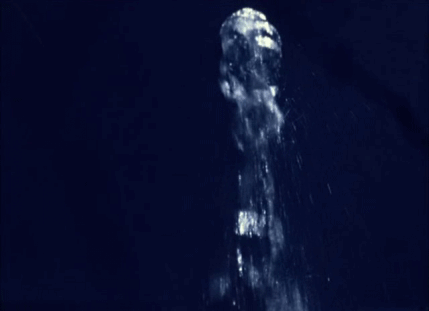

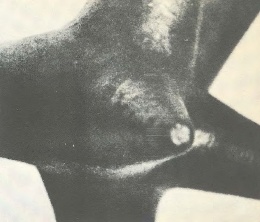


____
Further
Marie Menken @ IMDb
Marie Menken @ Wikipedia
‘Notes on Marie Menken’
‘Making Light of IT: Marie Menken’
Marie Menken @ The Filmmakers Coop
‘Who’s the Source for ‘Virginia Woolf’?’
‘More Notes on Marie Menken’
‘By Marie Menken’
Marie Menken @ mubi
Video: Jonas Mekas talks about Marie Menken
‘Marie Menken and the mechanical representation of labor’
Marie Menken’s works @ Ubuweb
_____
Documentary

View an excerpt from Martina Kudlácek’s 2006 film on the influential New York experimental film maker, artist and woman-about-town, Marie Menken. Given access to Menken’s archive by her nephew, Kudlácek mixes rare footage with a soundtrack by John Zorn and interviews with Menken’s contemporaries, including Kenneth Anger, Stan Brakhage, Gerard Malanga, Jonas Mekas and Billy Name. Written and directed by Martina Kudláček, camera: Martina Kudláček, editor: Henry Hills, sound: Judy Karp, original Music: John Zorn.
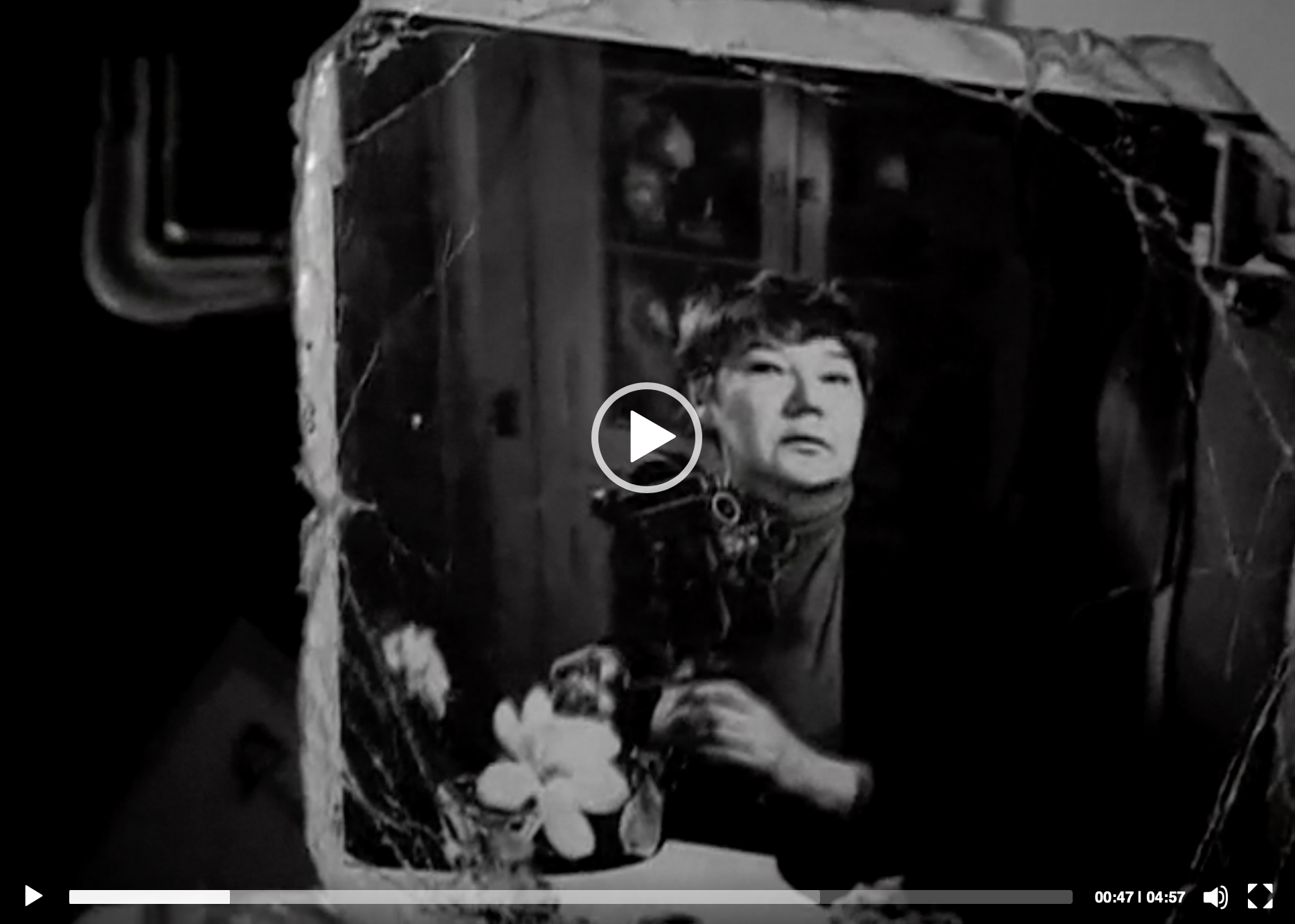
_____
Marie Menken in Andy Warhol’s The Chelsea Girls
‘Reel #10 from The Chelsea Girls. This reel is silent in the 3 hrs 15 mins theatrical release. Andy Warhol: “Willard Maas and Marie Menken were the last of the great bohemians.” They wrote and filmed and drank—their friends called them “scholarly drunks” and were involved with all the modern poets.” Menken was a significant part of the inspiration for the character Martha in Edward Albee’s 1962 play Who’s Afraid of Virginia Woolf?’ — davesshindig
_____
Paintings
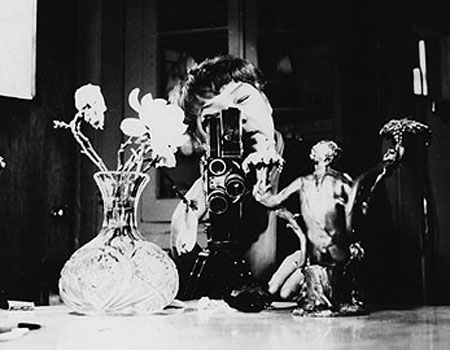
‘Marie Menken was known initially not for her films but for her paintings she made from sand and other nontraditional materials. Her first show opened at the Betty Parsons Gallery in November 1949 (the show that followed hers was Jackson Pollock’s), and her paintings were described before the opening by F.Y.I, the employee newsletter of Time, Inc., where she worked as a night clerk on the overseas cable desk. According to F.Y.I., her paintings were made from “stone chips, stone powders, marble chips, marble dust, ground silicate, sand, cement dust, luminous paints, glass particles, glues and lacquers, occasionally string and fiber. ” So Dwight was perhaps right to call these paintings desertipicti; the species epithet means “of the Painted Desert.” Menken had a second show at Betty Parsons in February 1951, and her third, held at Tibor de Nagy the following month, featured Pollock-like swirls of phosphorescent paint that glowed in the dark.

Marie Menken, If Earth in Earth Delight, 1951, oil, sand, glass, and thread on masonite, 11 ½ x 17 ½ inches.
‘Menken’s paintings are . . . “idiosyncratic” is the word likely to be employed. She experimented with sand, string, glass–like a Julian Schnabel aforehand, though on a human scale. The paintings are on masonite (board), not canvas. Except for one, which is on brown paper that has been crumpled, rubbed with what appears to be colored pencil, and then stretched more-or-less flat again. The masonite, at least in the case of IF EARTH, appears to have been trimmed by hand–which explains the irregular edges of the image I sent you.
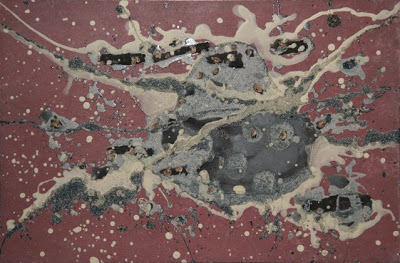
Marie Menken, Untitled, [1951], oil, sequins, shells, and phosphorescent paint on masonite, 12 x 18 inches. Not signed, not dated.
‘The paintings on masonite, including IF EARTH IN EARTH DELIGHT, are stuccoed with sand, strings, beads, glass, etc. They are not all so brown as IF EARTH. One is mostly green, as I remember, another reddish. Another has Pollock-like swirls of phosphorescent paint studded with tiny shells. I did not know it was phosphorescent until one night I went into the dark basement where all the Ripley stuff was being unpacked . . . and got quite a start. It seems pretty clear Menken liked the play of light, just as she says somewhere. Because of the raised and encrusted surfaces of the paintings the light dances or changes patterns according to your angle of viewing–even in the work made from dull crumpled paper.

Marie Menken, Doctor Coon’s Ghar Hotu, 1951, oil, sand, and thread on masonite, 11 ½ X 21 inches.
‘While Martina [Kudlacek] was making her documentary of Menken, she preserved for Anthology Film Archives footage Menken shot in Guadix Spain [Gravediggers of Guadix] during the same 1958 trip with Kenneth Anger which resulted in her Arabesque for him at the Alhambra. The Guadix footage is unforgettable. Spooky monks, who look like they will retire to their cells to flog themselves or each other, are repetitively spading, spading, spading the red Spanish earth . . . and Menken’s camera goes to that earth as if it can’t help itself. The effect, I remember, is exactly as you say about her camera: it’s stop-start, momentum infused with the potential of interruption, lingering and delay. I even seem to remember that the earth hits the lens at some point….

A Green Dream, 1946, oil, sand, glass, and thread on masonite, 13 x 13 inches.
‘The comparison to IF EARTH IN EARTH DELIGHT is dramatic. The painting was shown at Betty Parsons in 1951 and the film wasn’t shot until 1958 but in each the texture, the color, the granularity–even in a way the non-translucent limits of the dull, unreflective medium of earth–are made to do a lot of esthetic work on our behalf. Put this similarity together with her George Herbert title (it’s from the poem “The Priesthood”) and one could work up a whole exegesis. Speculative, but then, she’s the one that picked the title.
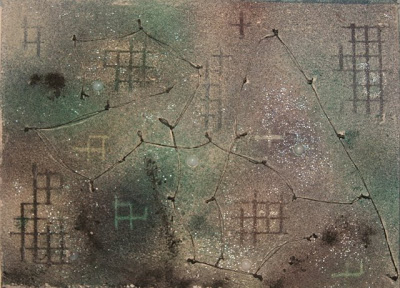
Ten Cents’ Worth of Tears, 1954, oil, sand, beads, and thread on masonite, 9 3/4 x 13 3/8 inches.
‘The stanzas in the middle, where the title comes from, are so much to the point that she could not have been innocent of them. “Yet have I often seen, by cunning hand / And force of fire, what curious things are made / Of wretched earth.” And next: But since those great ones, be they ne’er so great, / Come from the earth, from whence those vessels come; / So that at once both feeder, dish, and meat, / Have one beginning and one final sum: / I do not greatly wonder at the sight, / If earth in earth delight.’ — Douglas Crace
________________
15 of Marie Menken’s 24 films
_______________
Visual Variations on Noguchi (1945)
‘Visual Variations on Noguchi is a riveting visual study of the dynamic relationship between film movement and sculptural form. Marie Menken made the film while looking after Isamu Noguchi’s MacDougal Alley studio in 1945. It is both Menken’s first film, and the first within in a series of her films that study the work of prominent modern artists including Piet Mondrian, Dwight Ripley and Andy Warhol. Produced at a particularly rich moment of innovation within the avant-garde, the film can be read as an important intermediary between visual art and cinema in post-war North America. As such, it is an indispensable film for contemporary viewers of cinema and modern art alike.’ — Senses of Cinema
Excerpt
______________
Glimpse of the Garden (1957)
‘Marie Menken was a pioneer of experimental film in the New York avant-garde scene; known as The Body by Andy Warhol and her peers she struck an imposing figure at a formidable six-foot-two inches tall. Her marriage to poet Willard Maas and their wicked arguments inspired playwright Edward Albee’s Who’s Afraid of Viriginia Woolf and her salon-home was a sort of proto-factory, the place where Warhol met Albee, Marilyn Monroe and filmmaker Kenneth Anger.At odds with her size Menken’s ‘little, little’ films are often feminised, described as lyrical and ephemeral they are known for their fragility of movement and intuitive sense of pace. Glimpse of the Garden (1957), filmed through a magnifying glass is a visual poem that illuminates the strange in the ordinary. In a collage of textured close-ups flowers and plants take on a surreal quality, shifting streams of foliage dance to a phonographic recording of birdsong and Menken’s somatic camera delicately captures the everyday act as an act of art.’ — The Plant
the entire film
_______________
Dwightiana (1959)
‘Menken’s 16mm, stop-motion tribute to the art of Dwight Ripley was filmed in 1959 in his apartment at 416 East Fifty-eighth Street in New York. She used his drawings as flats.The remarkably contemporary soundtrack for steel drum, guitar, flute, and voice was written for the occasion by Maya Deren’s young husband, Teiji Ito, and is available in his album Music for Maya (Tzadik). Stan Brakhage called Dwightiana a pioneer example of the film portrait, abstract rather than narrative (the colored pencils represent Ripley’s palette). Ripley was also a botanist, and Menken’s unusual title alludes to botanical nomenclature as if Dwightiana might be the name of a species as well as a work “about” Dwight.’ — Dwight Ripley Info

________________
Arabesque for Kenneth Anger (1958 – 1961)
‘Arabesque for Kenneth Anger is Marie Menken’s tribute to her fellow avant-garde filmmaker, Kenneth Anger, whose influence obviously looms large over this expressive, evocative short. The film, shot in a Moorish palace in Spain over the course of an afternoon, is concerned, as Anger always was, with light and color, and especially with the ways in which forms could be made to interact with the tempos of music and cutting. The film is set to a lively score by composer Teiji Ito, who combines Spanish guitar and castanet motifs with Japanese-influenced reeds, resulting in a driving, vivacious score that’s perfectly suited to Menken’s imagery. Although the score was made later, to fit the short, the film sometimes seems to move with the tempo of the music, as when the circular ripples in a puddle dance to the beat of the snapping castanets. Even better is a wonderful section where the film takes on the stuttery rhythm of the percussion as the frame seems to jump and skip, giving the illusion of a sideways motion through a courtyard but in fact repeatedly returning to the same spot again and again. The black edges of the frame take on the function of cutaway walls, so that the viewer is faked out into believing that the camera is moving from one room to the next. It’s a compelling image of being in constant motion while never quite going anywhere; the camera is essentially running in place.’ — Only the Cinema
the entire film
____________
Eye Music in Red Major (1961)
‘A study in light based on persistence of vision and enhancement from eye fatigue.’ — M.M.

____________
Drips In Strips (1961)
‘Spattered paint responding to gravity, forming its own patterns and combinations of color.’ — M.M.
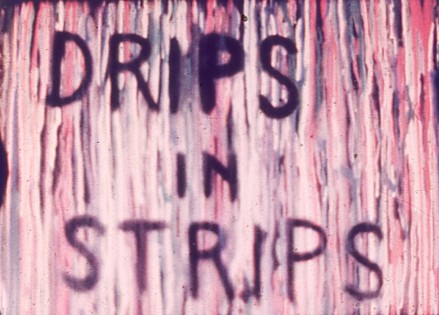
____________
Wrestling (1964)
‘Described as a ‘TV concrete’ by filmmaker Marie Menken, Wrestling is visual variations on a televised wrestling match.’ — David Lewis

_______________
Mood Mondrian (1965)
‘”A film of a painting of a sound. Piet Mondrian’s ‘Broadway Boogie-Woogie’ is translated into visual boogie rhythm.” –M.M. “Mood Indigo can already be described as an extraordinary and perhaps revolutionary cinematic achievement.” — Joseph LeSueur. In 2006, John Zorn wrote a belated, ideal score for Menken’s film Mood Indigo. It was included in the album Filmworks XVII: Notes on Marie Menken/Ray Bandar: A Life with Skulls (Tzadik Records).’ — collaged
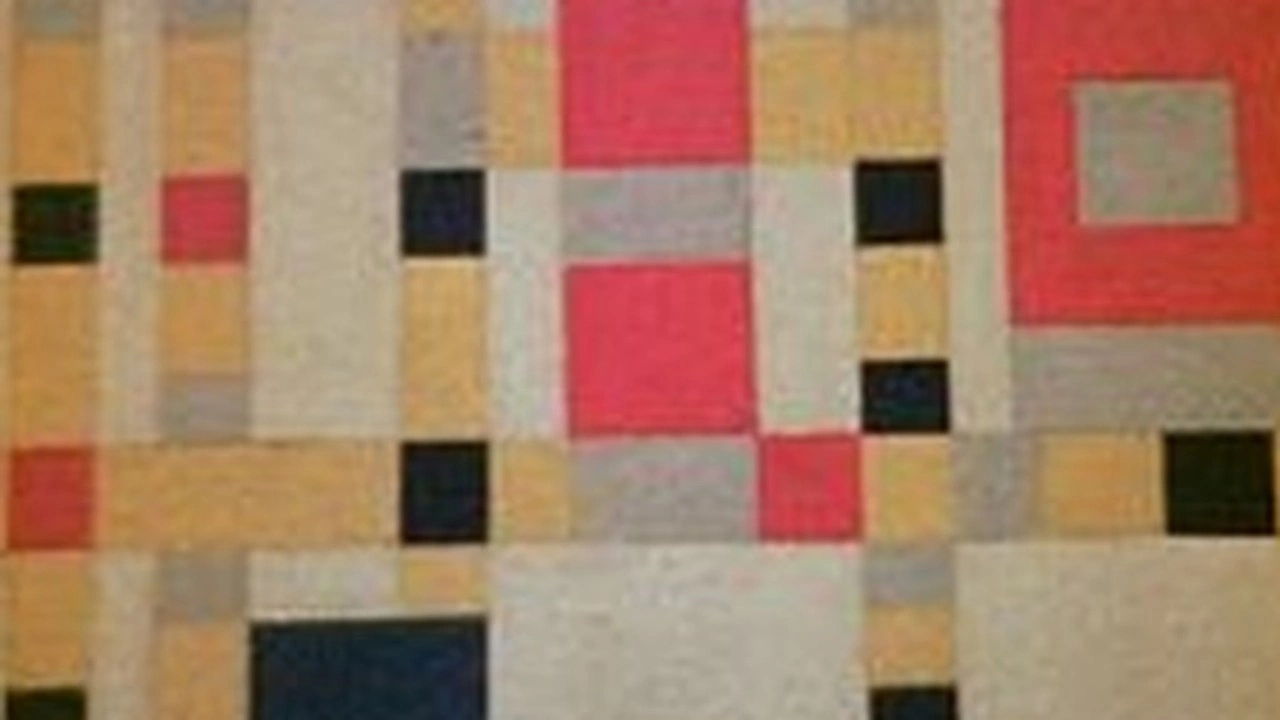
______________
Andy Warhol (1965)
‘Using a hand-held camera, Menken captures Warhol and his assistants as they work at the Factory. The result is an intimate portrait of the artist in the process of creating some of his most famous works, including the Brillo boxes, the Jackie series, and the Flowers silkscreens.’ — MUBI
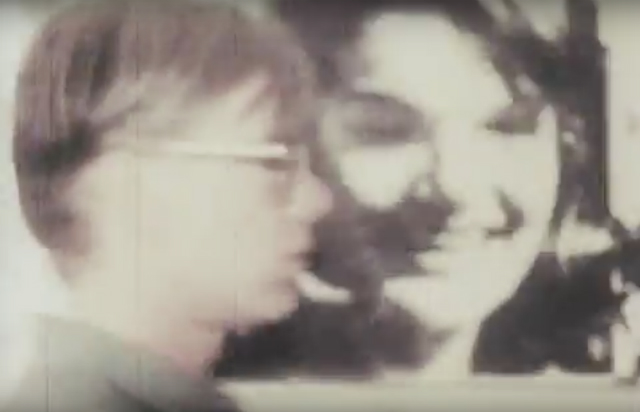
______________
Moonplay (1964 – 1966)
‘An expansion upon an idea put forward in Marie Menken’s film Notebook; single-frame footage of the moon shot on various nights, blinking and darting around within Menken’s field of vision.’ — David Lewis, All Movie Guide
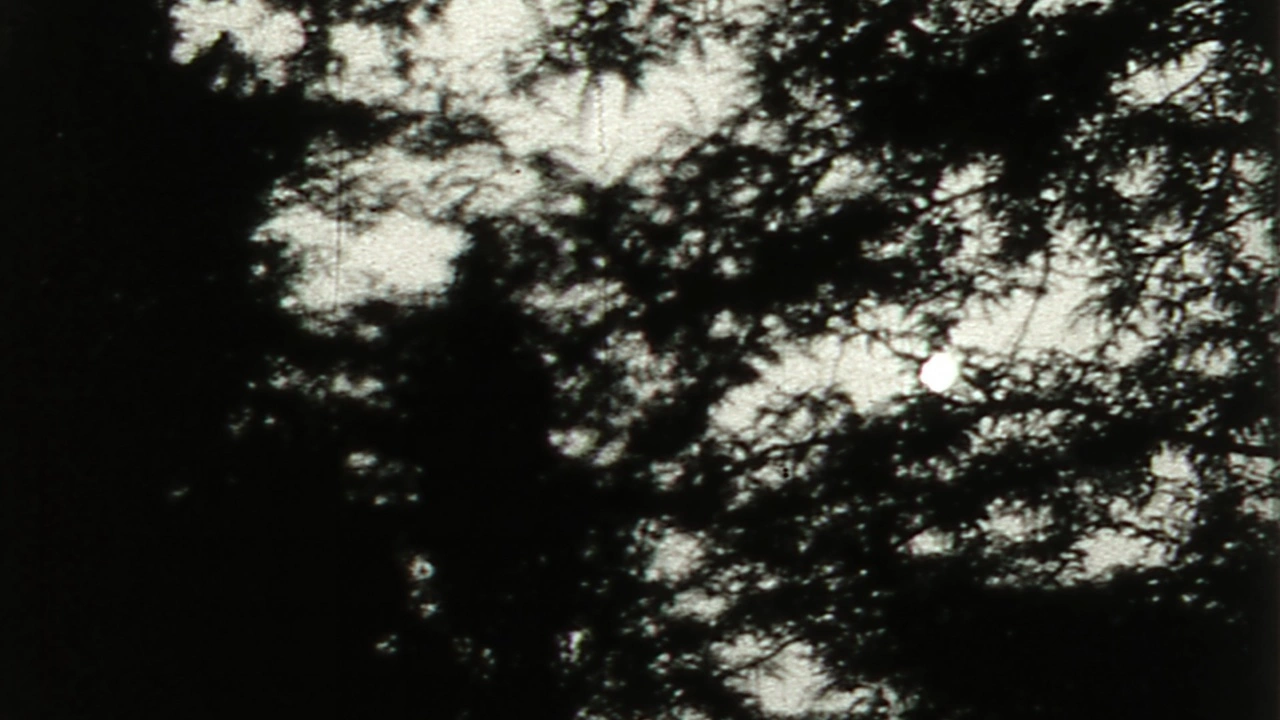
______________
Go! Go! Go! (1962 – 1964)
‘In transit across the Brooklyn Bridge, cables and railings whirr and weave, interrupted by lampposts beating across the frame. Now in Manhattan, window grids pulse and ripple. Reflected sunlight off the metal of cars and trucks, strikes the screen. Wooden crates, iron railings, construction barriers flutter by. Blocks of stuttering bricks and windows are punctuated by foreground figures–pedestrians, cars, broad sides of trucks–popping in and out of frame. Sometimes the frame of the car window from which Marie Menken is capturing these single-frame samples hovers in view. A flurry of images mark out the density and clutter of vendor’s wares. A collage of urban signage stamps its imperatives of grabbing and directing attention; these signs fly at the screen too quickly to be read, leaving viewers instead with their collective impact of attraction.’ — Angela Joosse
the entire film
_________________
Lights (1966)
‘”Made during the brief Christmas-lit season, usually between the hours of midnight and 1:00 A.M., when vehicle and foot traffic was light, over a period of three years. Based on store decorations, window displays, fountains, public promenades, Park Avenue lights, building and church facades. I had to keep my camera under my coat to warm it up, as the temperature was close to zero much of the time.”‘ — M.M.
the entire film
______________
Sidewalks (1966)
‘Marie Menken points her camera downward and picks up the rhythms of walking and its visual counterpoint in the patterns of sidewalks.’ — David Lewis, All Movie Guide
‘Sidewalks’ projected behind a performance by Richard Barone
____________
Watts with Eggs (1967)
‘By 1967, Menken had become interested in the work of Fluxus artist Robert Watts and made a short animation piece, Watts with EGGS, in which she animates his chrome-casted Box of Eggs. The film opens with lights reflected in the eggs (of course), then, through single framing, pixilates a man’s hand arranging eggs in different patterns. The hands (those of John Hawkins) fill the box back up with eggs. Next, the eggs do the same routine, but more magically, more serenely, without the assistance of the hands. Menken also introduces a string and a feather duster into animated action, so that the eggs, one by one, seem to be coming directly out of the duster (objects infect objects). By the end, the eggs are magically back in their box.’ — Melissa Ragona
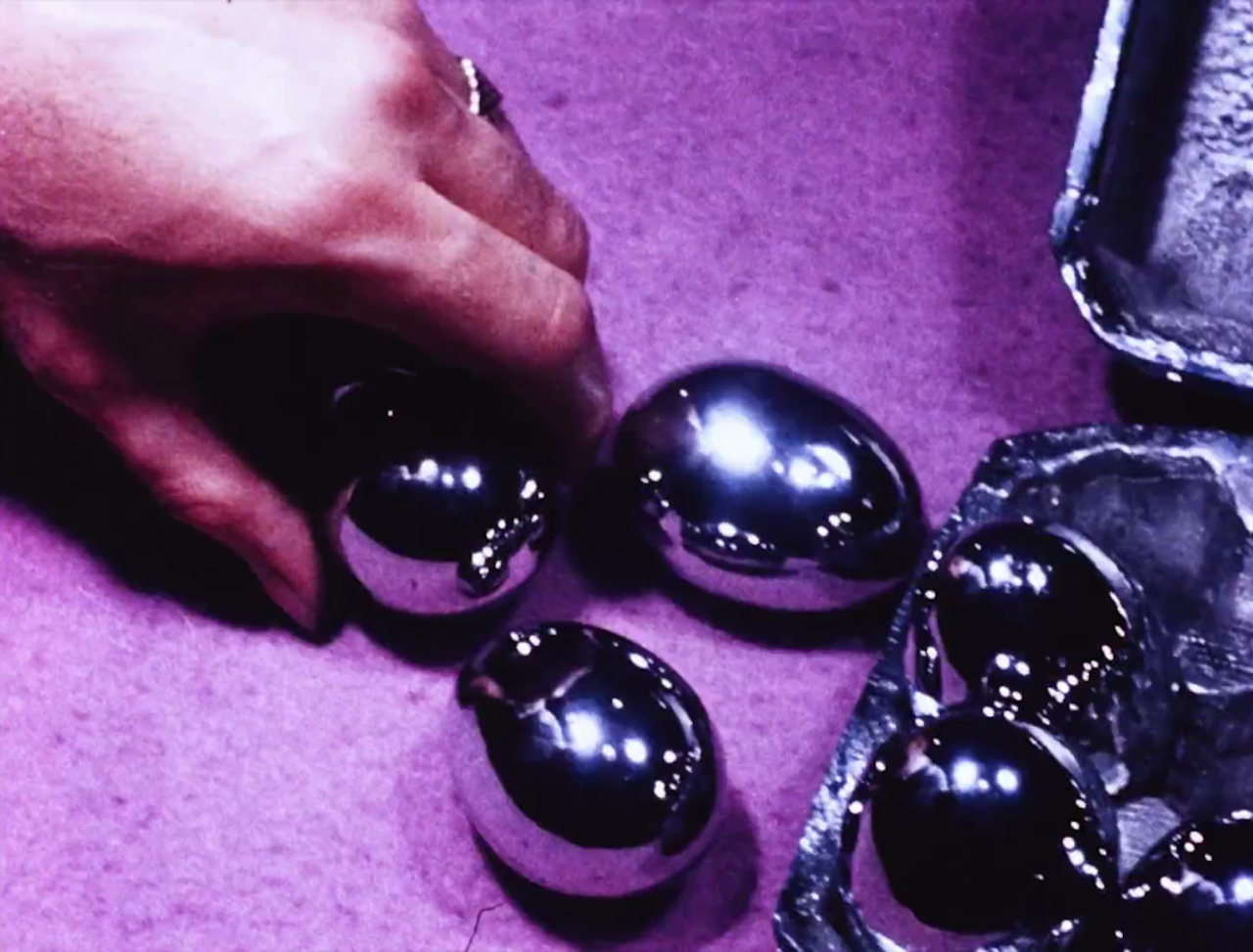
____________
Excursion (1968)
‘A boat trip with friends round Manhattan, shot in single-frame mode – it gets dark.’ — Ute Aurand

*
p.s. RIP Joe Mills. I’m very sad to announce the death of a very long time distinguished local of this blog. Joe commented here and contributed to the post’s content for many years, and he was great friends with many of the long standing commenters and local community. A few veteran d.l.s are putting together a memorial post about Joe that will appear here very soon. ** Dominik, Hi!!! Ah, shit, at least I got to see five songs by Destroyer. Sucks for you. Very hard to pick a favorite. There were quite of number of those haunts I liked the look of a lot. Haunted Hoochie is really legendary, and that’s definitely in the running, Psycho Path: The Dark Ride very possibly, or maybe Crawford School of Terror? But, oh, yeah, I’ve always wanted to visit Dent Schoolhouse too. Can I maybe sort of glue them together to make a haunted McMansion? Love pissing on a scalding hot rock for some reason, G. ** David Ehrenstein, Ah, that makes sense, and, of course, that is the obvious very high priority. ** l@rst, Hi. No, knowing how the internet and browsers work, I wasn’t expecting dancing pages, don’t worry. I loved what it is. Sweet, man! Haunted things are getting pretty expensive these days. Understandable, but I do miss the days when haunts had an empty tin can by the entrance with a ‘if you feel like it’ post-it attached. I think there are a couple of pretty terrific looking haunted houses in your area, if I’m not mistaken. ** _Black_Acrylic, Hi, Ben. Unfortunately all the haunts in the weekend post are outside of California, so I won’t be able to partake. But I’m going to hit as many of the haunts in the earlier SoCal-centric post as humanly possible. ** Jack WV, Hi, Jack! Good to meet you, and welcome! My pleasure on the post, of course. So are you over your haunted house attraction days? Might I have possibly reawakened it a bit? Please come back and hang out anytime. ** Steve Erickson, Hi. Yeah, it looks really different than ‘The Assassination …’, which I also liked. I don’t know, Marilyn Monroe, I guess I just don’t know if I need more about her. ** h now j, Hi. Sorry I missed your comment. No, it looks like I’ll just miss you in LA. Oh, right, it’s a holiday there. Are you able to use it to have holiday in some way? ** Paul Curran, Not bad, right? Excellent, my eyes and my email will be having a an anticipatory staring contest. Thanks, bud! ** Brian, Hi, Brian! Yeah, you know, I’m all scholarly about them and never get scared, but I know I’m nerdy/weird. They’re great folk art at their best, for sure. Yes, our new film is about a family who builds a haunted house attraction in their home. Upper East Side, interesting. In my head I had you downtown, I guess just because that’s where the campus is. Jeez, what a boring Gothic Lit class, what the hell?! Your prof is asleep at the wheel. What are you thinking of doing with/about ‘The Damned’? That’s pretty interesting. I was in LA last July, but I haven’t been there since then, and now I’ll likely be there a fair amount until we’ve shot the film. LA has some very sweet haunted houses that I will be a total pest of a chin-rubbing, time-consuming visitor, yes. Also, Zac and I are hoping to talk to the makers of the best ones and see if they’d either give or lend or rent us their props and decor for our film because our budget is, like, very tight. How was your weekend? ** Jeff J, Hi. As I told Dominick, i’ve always been really curious about The Haunted Hoochie because it’s such a legend. And Dent Schoolhouse too actually. But there were quite a few where I felt pain at being stuck in my imagination. Your EP is on my today calendar. Wow, I just typed calendar. I’m sure I’ll see Michael. I haven’t talked to him, but I hear he’s doing okay. I’m pretty certain that Bookworm is never going to return, or at least not on NPR. I think there are people trying to talk him into doing it as a podcast. I don’t know if I can remember why I like ‘CG’ so particularly. Of course the economy appeals to me. Similar to how much I love ‘Wittgenstein’s Nephew’ which most Bernhard people consider very minor. I’ll have to think about it or pick it up and have another gander. It’s so great though, right? ** Prince S, Hey! Um, the new film will be ready to be seen sometime next year, but I don’t know when. We’re likely not going to shoot it until the beginning of the year, and then there’s the editing and finding ways to show it and stuff. Not before the summer at the earliest, I suspect. Of course, yes, what’s going in Iran. Horrible, horrible, but it seems so … promising? Like maybe an actual breakthrough? I know so little to nothing about how things work there, but seeing people seriously and collectively and in a big way battle dictatorship with such belief and seeming ferocity is very exciting. New book! Whoa! Incredible! Excited! Wow. What a funny dream you had. Of course in real life I would never ever be like that. Which is, I guess, the humor’s source for me. How’s your week looking? ** Okay. This Marie Menken Day isn’t from hugely long ago, about five or six years back, but, since I originally made it, much more of her work has become available to watch online, so I decided to give it an upgrade and expansion and relaunch it, so there you go. She’s great. Visit her/it please. See you tomorrow.




 Now available in North America
Now available in North America 
Oh sad to read the passing of Mr. Mills. i remember his contributions here. Sad news. Somehow i feel this Marie Menken post suits that mood of loss. Not sure why.
i love Menken’s work… (actually, much more than Mekas’s work)… partly because of her disciplined (and obsessively erotic) visual experiments across mediums… and her affinities with Warhol’s work seem to keep me interested in both artists… Thank you for the expansion of the post! Wow, i didn’t know some of these are now fully available online. What a gift. i will immediately watch “Excursion”… Never heard it before. Hope “Moonplay” will be available somehow also. Sounds like resonating with Germaine Dulac’s rhythmic practice… possibly, more playful than Dulac’s? curious…
My holiday weekend has been oddly hectic but I will use today for my unfinished & very overdue essay on Warhol…. hope you are having a satisfying work (and pleasure) day!
Hi!!
Thank you for updating and reviving this post!!
You can absolutely build a haunted McMansion from all the haunts you’d like to visit! It’s your vacation home after all! (The Crawford School of Terror looks tempting too, yes! I guess I have a soft spot for school-themed haunts.)
Well, why not? If that’s what love’s heart desires! The image and the associated sensory elements are strangely pleasing. Love deciding that never, under any circumstances, in any universe, will he become a professional diver, Od.
Hey, Dennis.
Thank you for speaking of Joe, and the upcoming remembrance day. It’s been a sad weekend, to say the least. I think it’s important, though, to say that it was through your blog that I even had the chance to know him, and to be around in his later years. It’s kind of a legacy from the early days here that we all kept up with, and it’s so good knowing that it has resonance. We weren’t entirely just voices on the internet; we connected and we mattered.
Love from a country half a step over, over here.
Marie Menken and Willard Maas were the directinspiration for “George and Martha” in “Who’s Afraidof Virginia Woolf”
hey Dennis – That’s awful news about Joe Mills. I’m glad there will be a remembrance post.
Nice to see this expanded Marie Menken day with so many new films available. I don’t think I knew anything about her paintings, either. I wish that doc about her was better. It felt like a missed opportunity.
I’m glad to hear Michael is better, though it’s shocking that BW won’t return to radio. Do you know why?
Carpenter’s Gothic is extraordinary. Parts of it had the feel of a great Cassavetes film to me — how completely he immerses you in scene and character, the relentlessness of the style which is also the urgency of the dialogue, the characters trapped with each other in a small space, putting so much pressure on emotions that they spill over in unexpected ways b/c they have nowhere to go. It’s fascinating how much plot happens off stage, too.
Never understood why Wittgenstein’s Nephew was considered minor either. It accomplishes so much in a short span and with a punch of emotion.
Thanks for checking out the JC tracks.
I am thankful for this Marie Menken Day plugging gaps in my avent garde film knowledge.
RIP indeed Joe Mills. I remember he and my dad got on really well when they met at the PGL screening in Glasgow 2019.
When I saw this day’s headline I thought, “I’ve seen her name before, but where?” And then I remembered the Warhol connection.
RIP Joseph Mills. Incidentally, my last exchange with him on Facebook was back in February of this year, and characteristically, involved Lady Gaga. I guess I feel a bit numb about it, as if it hasn’t really sunk in yet.
Dennis, Thanks for that about Joe. He’s already greatly missed. Just got off the phone with Rigby, after about 3 or 4 hours, hahaha. Yeah, it’s devastating to us.
Well, I hope the memorial day, which we’re working on furiously, is competent, hehe.
I’m afraid that Bones and All movie might get silly by the end. That’s my fear. But I do have hopes for it. Reviews so far seem pretty good. But we’ll see.
I’m off today because of the holiday, so will be working on stuff.
DC! How are you?
Thanks for reviving this day. I think Lights is one of the most beautiful things I’ve ever seen and I’m looking forward to watching a few more of the full films featured within. I’m also wanting to get Ari to watch it, but it’ll have to be by way of some barter. But I do think certain kids shows are close to certain experimental films, so who knows, she may end up a MM fan. Also, the full doc about her (MM not Ari) is on her Ubu page.
In other news, I’m coming to Paris tomorrow/today by the time you read this. It’s all a little last minute, so no worries if you’re busy, but I’ll be kicking about in the afternoon if you’re at all free to grab a coffee or something. Hannah’s doing some archival work in a library there, so I’m popping down for the day and we’re going to see the Joan Mitchell show on Wed. Is there anything else you’d recommend in your hood atm?
Sporty but still interesting love,
Jamie
Wow, these images are stunning! Thanks for sharing. I shall investigate her work properly when I can. My week… oh, thanks for asking, but it’s looking kind of grim… I have a reading, then more teaching & commuting, and possibly a hospital appointment… plus no proper sleep & sore throat… No fun & games pour moi this week or in the near future indeed. What about your week? Surely, yours is much more DC than mine? The only nice thing is I’m finally reading T Bernhard, and I’m vibing super hard with it! I’m reading The Loser now; I know your fave is Concrete, so that’s next on the list. My brother wants to translate it. We are learning to do tarot. I love your reading of the situation in Ir, and I do hope you’re right, but I’ve also lived there long enough to know that despite the people’s wrath and courageous eruptions, the regime will find a way to stay – usually by killing (literally erasing all the protesters), so I’m not too hopeful… They’re so ignoble, and I’m starting to understand and accept that I’ve lived most of my life in fear because of them, although I did have a v sheltered life there but still… I am learning things & none of it is pretty. Anyway, your film sounds really exciting! Is this Room Tempreture? I will of course welcome it with open arms whenever it arrives. Mwah xxx
RiP, Joe. xx I bet he would have loved this Marie Menken Day. Look forward to the memorial post.
Emailed you, Dennis…
Hey, Dennis,
Another hole in my knowledge of avant-grade cinema filled by another wonderful post on your blog, yay. On haunted houses, I definitely have that sort of scholarly “objectivity” or formal interest in them when I’m outside, and honestly I would totally love to help design or participate in one behind the scenes, but actually walking through them as experienced seems too intimidating for me (I’m a scaredy-cat at heart). No disagreement on their potential greatness as folk art, though. My college campus is actually on the Upper East Side too, not downtown. A CUNY school on 68th Street. Of course I applied to the downtown schools, and most of my sort of friends go to downtown schools, and I spend much of my free time downtown, but my school and living is localized up there. Yeah, I was majorly disappointed in the Gothic Lit stuff. And the professor is super nice and seems really interested in what I have to say, but I feel like I’m kind of pushing back a lot, because she’ll be openly dissing, like, Ann Radcliffe or Caspar David Friedrich, and I’ll have to jump in and try and make a defense for their formally or aesthetically interesting qualities, even though they’re tacky and melodramatic…which is not what I expected I’d be having to do in a Gothic Lit class at all, but here I am. “The Damned” paper is, perhaps banally, trying to articulate my idea of what’s going on with Visconti’s depiction (and non-depiction) of homosexuality in the movie. Because the standard line in scholarship about the film is that it invented the gay Nazi trope, that it equates fascism with homosexuality, and I think that’s stupid and I’m sick of reading it, so I’m trying to get at something hopefully more complex. But it’s not the most interesting thing you could write about that very interesting movie, of course. I imagine it’s cool/exciting to have such a possibly long stretch in LA ahead of you. I hope so. Ooh, collaborating with haunted house makers, that’s rad if it happens. My weekend was decent—two NYFF movies on Saturday (both pretty good), visited yesterday and today because my brother’s back from school. No complaints. Yours?
Hello, CUNY friend! I teach at one of CUNY campuses. Not Hunter College, though! Your paper sounds so cool and A+! Enjoy the semester !!
hi dennis! i feel kinda weird asking or telling you about this but i thought i’d shoot my shot and say that if you’re not doing anything saturday night (oct 15), check out competition #5 at festival des cinémas différents et expérimentaux de paris (you *are* in paris, right?). my best friend and i have a film showing there called “knife play (for two angels)” that i hope you’d like. i won’t be there but alexander (the aforementioned best friend / director of the film) will be, all the way from nova scotia. if you see him, tell him i sent you. thanks for reading! hope you can make it. no worries if not (he doesn’t know i’m writing this)